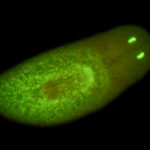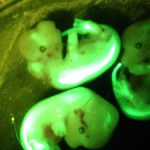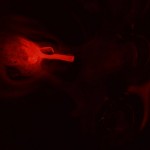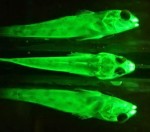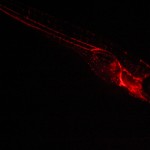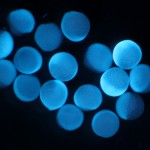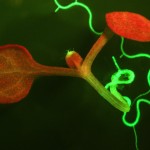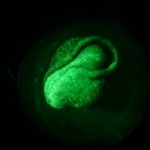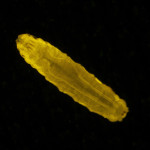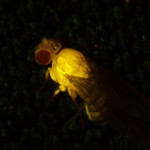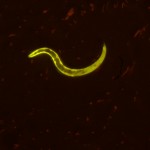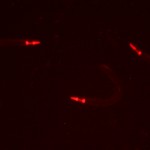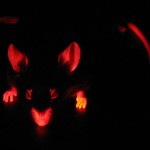Which Excitation Should I Use for My Fluorophore?
Which NIGHTSEA excitation and emission combination should I use for my fluorophore (GFP, FITC, RFP…)?
- NIGHTSEA offers five different fluorescence excitation wavelength sources with our economical Stereo Microscope Fluorescence Adapter and Xite flashlight systems. These can be used to excite a wide range of fluorophores. This page provides guidance on selecting the right wavelength set for your application.
- Table 1 lists the NIGHTSEA wavelength sets, including the most intense part of the excitation range and the cutoffs of the paired emission filters.
- Table 2 lists the wavelength set that we recommend for a wide range of fluorescent proteins and dyes. If you do not see your fluorophore on the list please let us know and we will add it. If you see any errors or can verify performance from your personal experience, please let us know that also.
What is the basis for the recommendations?
- Our recommendations are based on either working knowledge with that fluorophore – our own or feedback from customers – or on published spectral data. You can find a list of spectral databases on our web site (link). Two of our own favorites are FPbase and Searchlight, but there are quite a few others.
Table 1 – NIGHTSEA wavelength sets
Wavelength set names are sets based on the color of the excitation light, not on the color of the fluorescence that they will excite (see article on color coding). Note that with the Royal Blue excitation source we offer both longpass and bandpass filters.
| Designation | Excitation | Emission |
| UV – Ultraviolet | 360 – 380nm | 415nm longpass |
| VI – Violet | 400 – 415nm | 450nm longpass |
| RB – Royal Blue | 440 – 460nm | 500nm longpass |
| RB – Royal Blue | 440 – 460nm | 500 – 560nm bandpass |
| CY – Cyan | 490 – 515nm | 550nm longpass |
| GR – Green | 510 – 540nm | 600nm longpass |
Table 2 – Fluorophores and recommended NIGHTSEA wavelength sets
Key:
- Shaded/numbered cells – Fluorophores with shaded cells indicate that more than one Light and Filter Set might work for this fluorophore. This reflects a trade-off between maximizing the excitation efficiency and maximizing the emission capture. The color of the cell shading corresponds roughly to the emission color you would expect to see with that set.
- 1 – Our first choice based on either direct experience or on analysis of the spectra. There are a few cases where both choices are ‘1’ – either has the potential to work just fine.
- 2 – Our second choice
- Basis
- ‘W‘ – working knowledge
- ‘s‘ – analysis of spectra
- Standard disclaimer – The recommendation for the use of a wavelength set is not a guarantee that it will work in any given application. In addition to spectral matching, performance is also related to the total amount of fluorescing material and its fluorescence intensity.
| Fluorescent Protein/Dye | UV | VI | RB | CY | GR | Basis |
| Alexa Fluor 488 | X | W | ||||
| Alexa Fluor 555 | X | s | ||||
| Alexa Fluor 568 | X | s | ||||
| Alexa Fluor 594 | X | s | ||||
| amCyan1 | X | s | ||||
| Aquamarine | X | s | ||||
| Calcein | X | W | ||||
| Cerulean | X | s | ||||
| CFP | X | W | ||||
| Citrine | X | s | ||||
| Clover | X | s | ||||
| Cy3 | X | s | ||||
| CyOFP1 | X | s | ||||
| CyPet | X | s | ||||
| DAPI | X | W | ||||
| DASPEI | X | s | ||||
| Dextran-FITC | X | s | ||||
| Dextran-Texas Red | X | s | ||||
| Dextran-TRITC | X | s | ||||
| DiI | X | s | ||||
| DsRed | 1 | 1 | W | |||
| DsRed Dimer2 | X | s | ||||
| E2-Orange | X | s | ||||
| EBFP | X | s | ||||
| EBFP2 | X | s | ||||
| ECFP | X | W | ||||
| EGFP | X | W | ||||
| eqFP670 | X | s | ||||
| EYFP | X | W | ||||
| FAM (fluorescein) | X | W | ||||
| FITC | X | W | ||||
| Fluorescein | X | W | ||||
| FusionRed | X | W | ||||
| Fluorescent Protein/Dye | UV | VI | RB | CY | GR | Basis |
| GFP | X | W | ||||
| Hoechst | X | W | ||||
| iFP1.4 | 1 | 2 | s | |||
| KO1 | X | s | ||||
| LSSmOrange | X | s | ||||
| Lucifer Yellow | X | W | ||||
| mAmetrine | X | s | ||||
| mApple | X | s | ||||
| mAzamiGreen | X | s | ||||
| mBanana | X | s | ||||
| mBeRFP | X | s | ||||
| mCardinal | X | s | ||||
| mCherry1 | X | W | ||||
| mCitrine | X | s | ||||
| mEmerald | X | s | ||||
| mGarnet2 | X | s | ||||
| mHoneydew | 1 | 2 | s | |||
| MiCy | X | s | ||||
| mKalama1 | X | s | ||||
| mKate | X | s | ||||
| mKate2 | X | s | ||||
| mKeima | X | s | ||||
| mKO2 | X | s | ||||
| mKusabira-Orange | X | s | ||||
| mMidoriishi-Cyan | X | s | ||||
| mNeonGreen | X | s | ||||
| mNeptune | X | s | ||||
| mOrange | X | s | ||||
| mOrange2 | X | s | ||||
| Fluorescent Protein/Dye | UV | VI | RB | CY | GR | Basis |
| mPapaya1 | X | s | ||||
| mPlum | X | s | ||||
| mRaspberry | X | s | ||||
| mRFP1 | X | s | ||||
| mRFP1.2 | X | s | ||||
| mRuby | X | s | ||||
| mScarlet | X | s | ||||
| mStable | X | s | ||||
| mStrawberry | X | s | ||||
| mTagBFP | X | s | ||||
| mTangerine | X | s | ||||
| mTurquoise2 | 1 | 2 | s | |||
| mUKG | X | s | ||||
| mWasabi | X | s | ||||
| Nile red | X | W | ||||
| phiLOV2.1 | X | s | ||||
| RFP | 2 | 1 | W | |||
| Rhodamine B | X | W | ||||
| Sapphire | 2 | 1 | s | |||
| Superfolder GFP | X | s | ||||
| SYFP2 | X | s | ||||
| TagBFP | 1 | 2 | W | |||
| TagCFP | X | s | ||||
| TagGFP2 | X | s | ||||
| TagRFP | 2 | 1 | s | |||
| TagRFP-2 | 2 | 1 | s | |||
| TagYFP | X | s | ||||
| tdTomato | 1 | 1 | W | |||
| Texas Red | X | s | ||||
| TRITC | X | W | ||||
| Venus2 | X | s | ||||
| YFP | X | W | ||||
| Ypet | X | s | ||||
| ZsGreen | X | s |
Table 2 Notes:
-
- 1 – Our Green (GR) excitation/emission set can work with mCherry but is not optimal. We know of many people who have great success and others for whom it just did not work. It is likely related to the amount of fluorescing material and the strength of the expression. It is worth trying, but you should purchase only with the understanding that you need to try it in your application and might need to return it.
- 2 – None of our filter sets are a great match for Venus. We have had several customers try this. They could see expression but not very strongly.
Examples of NIGHTSEA utility:
- Fluorescein conrete thin section
- 100x
- FITC Planarian
- Rhodamine Planarian
- GFP Mouse embryos
- Micro-ruby dye fill of maxillary nerve (c) Robert Mitchell
- Calcein stained round goby (c) Greg Andraso / Kelly Grant
- GFP Zebrafish
- dsRed Zebrafish
- DAPI-stained zebrafish embryos
- GFP Arabidopsis
- GFP Axolotl
- Venus Drosophila larva
- Venus Drosophila
- YFP C. elegans
- mCherry C. elegans
- dsRed fluorescent mouse – actin labeled with DsRed
- GFP fluorescent mouse – actin labeled with GFP (c) Charles Mazel



